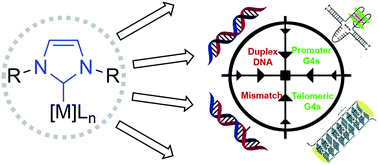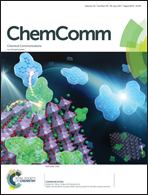On the binding modes of metal NHC complexes with DNA secondary structures: implications for therapy and imaging
Abstract
Organometallic compounds currently occupy an important place in the field of medicinal inorganic chemistry due to the unique chemical properties of metal coordination compounds. Particularly, metal compounds ligated by N-heterocyclic carbenes (NHC) have shown high potential for biomedical applications as antimicrobial and anticancer agents during the recent 15 years. Although further studies are necessary to validate the modes of action of this family of compounds, a number of biological targets have been identified, including DNA secondary structures. This perspective review aims at providing an overview of the most representative examples of metal NHC complexes reacting with nucleic acids via different binding modes. It is organized according to the type of DNA secondary structure targeted by metal NHCs, highlighting the possible advantages of biomedical applications, including therapy and imaging.



 Please wait while we load your content...
Please wait while we load your content...